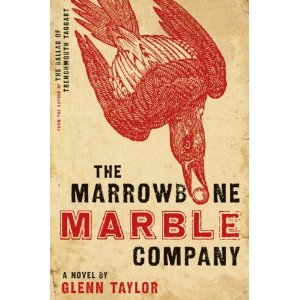 I admire the scope of this to
I admire the scope of this to
ugh, ambitious book more than I ultimately enjoyed it. Early on,
Taylor convinced me that this was going to be a character-driven book. But as the cast grew and the characterizations diminished, I ceased to inhabit it fully. The essential ingredient–individual portrayal–blurs into the larger themes of racial unrest within the genesis of the Civil Rights Movement. People became mere sketches. Except for the main protagonist, Loyal Ledford, the cast was populated by archetypes and one-dimensional figures. The author has a talent for earthy, gritty prose and his rendering of place is evocative. The soil and air of Marrowbone, West Virginia gets in your pores. But about one-quarter way through the book, it starts to meander, sag, and make its high points with platitudes.
Loyal Ledford was orphaned as a young boy in 1935 by a reckless, drunk father. He lingers in Huntington, West Virginia, tending the furnace at night at The Mann Glass factory and squires the boss’s daughter, Rachel, a company nurse. During the day, he goes to the local college. But he suffers from ennui and abruptly enlists as a serviceman in World War II. He returns after the war a haunted man from the horrors he has witnessed and the things he has done in the name of war. He is re-employed at Mann Glass, this time as a supervisor; marries Rachel; and starts a family. He befriends a black employee, Mack Wells, who has been subjected to ignorant prejudice. At night, Ledford is infected by abstract dreams that carry uncertain messages, which seem to be juxtapositions of past and future. He turns to whiskey for solace, which gradually alienates him from his home
life.
Ledford is thoroughly disgusted by racial prejudice at the workplace and in the county. He leaves Mann Glass and enlists the help of his distant relatives, The Bonecutter Brothers, in order to start up The Marrowbone Marble Company, an act inspired by his dreams. He persuades Mack to leave and come with him on this new venture. Loyal wants to do more than open a marble company. He desires to build a community that is based on kinship between black and white, a town that is built on integrity and the rights of human beings of all persuasions. One brick, one stone at a time, this town will grow to represent partnership and community between all ethnicities and colors.
He seeks out a scholar, Reverend Don Staples, who becomes his mentor in all things from philosophy to religion to basic human relationships. Staples is a gentle Christian, a thoughtful theologian, not a fire and brimstone preacher. Ledford quits drinking and reestablishes his role as husband and father. He is determined to put his demons at rest and forge a meaningful future at Marrowbone Cut. However, he also maintains a friendship with a fellow serviceman, Chicagoan Erm Bacigalupo, a crude man of little integrity–a bookie with mob connections.
It is a precarious undertaking to write a novel of race relations without tipping into the sententious and obvious. The author made it there by half, but it leaked around the edges. Don Staples became little more than a straw for Taylor’s pulpit themes, and Rachel and Lizzie (Mack’s wife) became mere wisps, undercut by the grandiloquence. In essence, the story was preaching to the choir (i.e. the reader). I do not need to be convinced that segregation was heinous, or to read pithy sermons about human decency and racial equality. I wanted to get back to the individual families.
Taylor’s focus and cadence drifted as his architecture staggered under its own weight. He selected a few individuals to expand upon, such as Ledford’s son, Orb. He gave him an Edgar Sawtell-ish construction, and his story, while precious, meandered until it also became fuel for the big battle of good vs evil. I felt cheated at the end. Taylor demonstrated an art for creating crisp and eccentric and fully realized characters at the opening of the book, then retreated from them and the story of two families–one white and one black–in order to fulfill his larger themes. Ironically, he filled his canvas with more and more characters–too many to handle with care–and I got weary of the soapbox, even though I agreed with his politics.
This could have been a five-star book; the author has a gift for storytelling, and, when he chooses to, solid characterization. The scenes of Ledford as a marine were powerful and the men in the corps were superbly depicted. The problems ensued when he traded out the rich and textured story for the grand platform. At that point, individuals became either caricatures or cursory sketches. Taylor gets his point across, and at times I was captivated; however, it was uneven and too often rhetorical. Nevertheless, I have faith in Taylor’s skill as a writer, and I will undoubtedly be in line for his next
book.

 Say You’re o
Say You’re o This is the best book I have rea
This is the best book I have rea I admire the scope of this to
I admire the scope of this to The Fires:
The Fires: 
